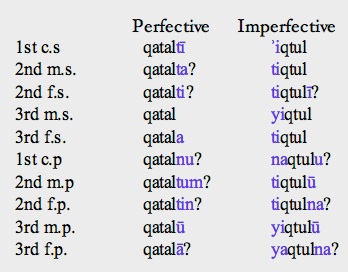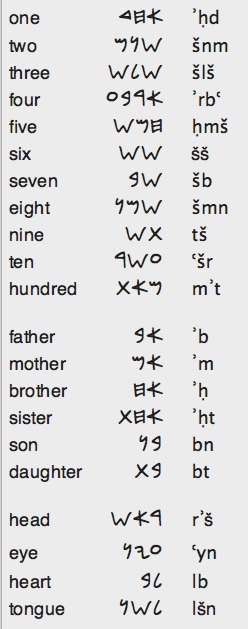An insatiable appetite for ancient and modern tongues


Classification. Afro-Asiatic, Semitic, Northwest Semitic, Canaanite. Phoenician was quite closely related to other Canaanite languages (Moabite, Ammonite, Edomite and Hebrew).
Overview. The Phoenicians are descendants of the Canaanites who around 1200 BCE were cut off from the interior of Syria and Palestine by the invasion of the 'Peoples of the Sea'. Confined to the coast, they founded a number of city-states (Byblos, Tyre, Sidon and others) but as the area was not rich in resources they explored and colonized the Mediterranean becoming seafarers and merchants. They had a key role in spreading the alphabet created by the Canaanites several centuries earlier. Their language, a typical Semitic one, is imperfectly known by some ten-thousand inscriptions which are almost always very short.
Distribution. Phoenician was spoken in ancient times on the coast of Syria and Palestine (in today's Lebanon and north Israel), in the cities of Tyre, Sidon, Byblos, and neighboring towns. Later, following the expansion of Phoenician merchants, it spread into many areas of the Mediterranean colonized by them like Cyprus, Malta, Sicily, Sardinia, southern Spain and North Africa.
Status. Extinct. Phoenician began to be attested, in what is now coastal Lebanon, late in the second millennium BCE and continued there and in various Mediterranean sites until Roman times. Punic, a variety of Phoenician, is attested in inscriptions from the North African colony of Carthage since its founding in the 5th century BCE until its destruction by Rome in the second century BCE though in some other North African locations it perdured until the 6th century CE.
Periods and Varieties
The chronological and geographical varieties of Phoenician are inextricably intertwined. They are:
Old Byblian. The early inscriptions from Byblos evidence a dialect different from that of Tyre and Sidon.
Late Byblian. During the Persian and Hellenistic periods, the dialect of Byblos assimilated some features of Tyro-Sidonian.
Standard Phoenician. Spoken in the Phoenician homeland and its colonies until the 6th century BCE, it was based on the dialect of Tyre and Sidon.
Punic. It was a variety of the Phoenician language spoken in the Carthaginian empire based in North Africa, including Carthage itself and several Mediterranean islands. It is attested from the 5th century BCE.
Late Punic. From the second century BCE and particularly after the fall of Carthage in 146 BCE, Punic experienced a number of phonological and morphological changes, probably influenced by the language of the Berbers. This Late Punic continued to be used by North African peasants until the 6th century CE.
Main Documents. Some Phoenician words and personal names are found in Greek and Latin classical literature as well as in Egyptian, Akkadian, and Hebrew writings. However, Phoenician is mainly documented by votive, commemorative and funerary inscriptions.
-
•12th-11th c. BCE. Brief inscriptions on arrowheads from the Beqa' valley and Palestine, and inscribed clay cones from Byblos. They consist only in personal names or patronymics.
-
•c. 1000 BCE. The Ahiram inscription, engraved in a sarcophagus found in Byblos, is the earliest substantial Phoenician inscription.
-
•5th-2nd c. BCE. Thousands of inscriptions commemorating child sacrifices from the tophet of Carthage.
-
•1st c. BCE. An inscription of Bitia is the latest from Phoenicia proper.
-
•2nd c. CE. The latest Punic inscriptions in the Phoenician alphabet.
-
•4th-5th c. CE. Latino-Punic inscriptions i.e. written in Latin script.
Phonology
Syllable structure. Most Phoenician syllables appear to have been, like the standard Semitic ones, consonant-vowel or consonant-vowel-consonant.
Vowels (7). Since Phoenician inscriptions did not usually include notation for vowels, they are less well understood than the consonants. The long-mid vowels e: and o: evolved from the Proto-Semitic diphthongs *ay and *aw, respectively. In transcription, long vowels are written with a macron (ī, ē, ū, ō).

Consonants (22). The consonantal system is distinguished by the existence of pharyngeal sounds represented by 'emphatic' (pharyngealized) stops and affricates as well as by pharyngeal fricatives.


Script and Orthography
Phoenician was written with a 22-character alphabet, read from right to left, that didn't indicate vowels.
This consonantal alphabet was adopted by the Greeks, who modified it to represent their vowels, and transmitted it to the Romans.
Transliteration is shown below each letter, and its equivalent in the International Phonetic Alphabet is given between brackets.
Morphology
Phoenician words are usually built around a triconsonantal root (less frequently biconsonantal) that gives the basic lexical meaning of the word plus vowels and affixes that provide grammatical information.
-
Nominal. Adjectives and nouns have the same morphology. They are marked for case, gender and number.
-
•case: nominative, genitive and, possibly, accusative.
-
•gender: masculine, feminine. Masculine singular nouns are unmarked; masculine plural ones end in m/īm. Feminine nouns, singular and plural, end in t. In the singular, t represents either t or ot; in the plural it represents either ūt or ōt.
-
•number: singular, dual (rare), plural.
-
•definiteness: Phoenician has a definite article (h) which is prefixed to a noun triggering the gemination (doubling) of the ensuing consonant. Nouns also become definite when they have a pronominal possessive suffix attached to them. Proper nouns are always definite.
-
•states: nouns occur in the absolute state or the construct state. A noun in the construct state governs a following noun in the genitive case constituting a construct chain. If the second noun is definite the entire chain is definite.
-
•pronouns: personal, demonstrative, interrogative, indefinite, relative.

-
Personal pronouns can be independent (shown in the table) or suffixed to nouns and prepositions. They distinguish gender and number except in the first person. Independent pronouns are emphatic and may be omitted because the verb is inflected for person, number and gender. The suffixed pronouns indicate possession.
-
Demonstrative pronouns have two deictic forms. The near demonstrative is: singular z (‘this’), plural ˒l (‘these’). The far demonstrative (‘that, those’) is identical to the independent 3rd person pronouns.
-
The interrogative pronouns are my (‘who?’) and m (probably mū) ‘(what?’). They also serve as relative pronouns. An indefinite pronoun (mnm) is attested.
-
Verbal. Phoenician verbs are inflected for person, gender and number through the addition of affixes and vowel patterns to the root.
-
•person and number: 1 s, 2 ms, 2 fs, 3 ms, 3 fs; 1 p, 2 mp, 2 fp, 3 mp, 3 fp.
-
•tense-aspect: perfective, imperfective.

-
The perfective indicates a completed action and usually has a past sense. The imperfective indicates an action that has not been completed and can have a present or a future sense; besides a change in the vowel stem it is marked by a prefix. Let's see the conjugation of the verb qtl 'to kill' (some reconstructed forms not directly attested are shown with a question mark):
-
•mood: indicative, imperative.
-
•voice: active, passive.
-
•derived conjugations: causative, reflexive, passive.
-
•non-finite forms: an infinitive construct that serves as infinitive and gerund; an infinitive absolute which might function as an adverb or stand alone as a non-inflected verb; active and passive participles.
Syntax
Phoenician syntax is not well known because of the dearth of long texts. The neutral word-order of Phoenician was the usual Verb-Subject-Object (VSO) of ancient Semitic languages. The alternative SVO placed emphasis on the subject. Nominal sentences (without verb) were frequent as the verb 'to be' was omitted in the present. Free-standing and inseparable prepositions (prefixed to a word) were used to indicate syntactical relations.
Lexicon
The original stock of Phoenician words incorporated some Aramaic as well as Greek and Latin terms (specially in late inscriptions). North African inscriptions reveal also a few Numidian loanwords.
Basic Vocabulary. The Phoenician characters should be read from right to left but their transliteration from left to right.

-
© 2013 Alejandro Gutman and Beatriz Avanzati
Further Reading
-
-'Phoenician and Punic'. J. A. Hackett. In Ancient Languages of Palestine and Arabia, 82-101. R. D. Woodward (ed). Cambridge University Press (2008).
-
-A Grammar of Phoenician and Punic. S. Segert. Beck (1976).
-
-Phönizisch-punische Grammatik (3rd edition, revised by M. Amadasi Guzzo). J. Friedrich & W. Röllig. Analecta Orientalia 55. Pontifical Biblical Institute (1999).
-
-The Phoenicians. S. Moscati (ed). I. B. Tauris (2001).
Phoenician

Address comments and questions to: gutman37@yahoo.com
MAIN LANGUAGE FAMILIES
LANGUAGE AREAS
Languages of Ethiopia & Eritrea
LANGUAGES by COUNTRY
LANGUAGE MAPS
-
• America
-
• Asia
-
Countries & Regions
-
-
Families
-
• Europe
-
• Oceania